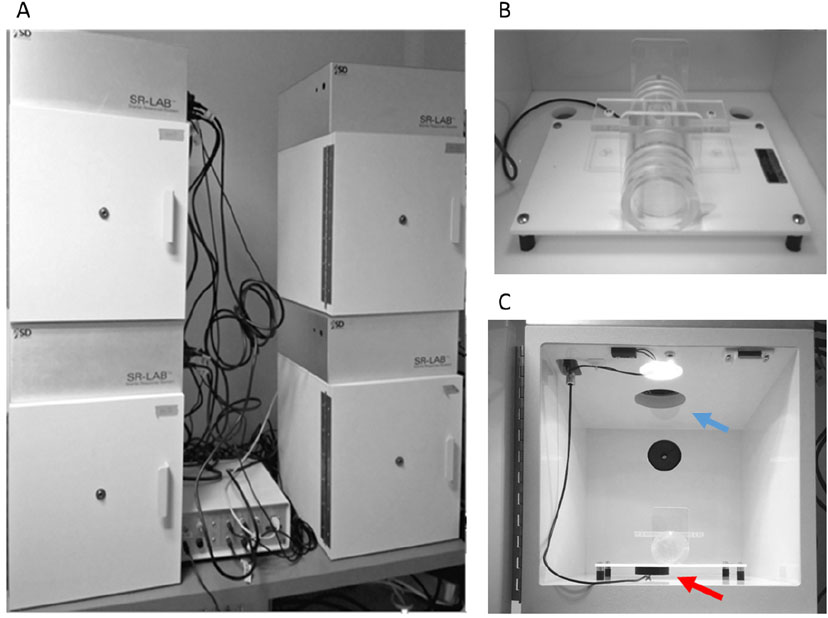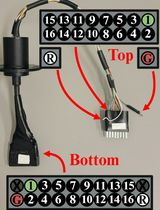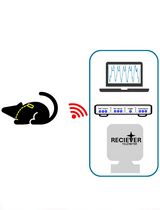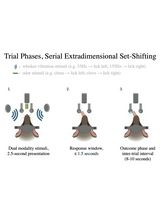- EN - English
- CN - 中文
Assessing Prepulse Inhibition of Startle in Mice
评估小鼠惊吓的前脉冲抑制
发布: 2018年04月05日第8卷第7期 DOI: 10.21769/BioProtoc.2789 浏览次数: 11420
评审: Xi FengJuan Facundo Rodriguez AyalaAnonymous reviewer(s)
Abstract
Animal models are an important tool for studying neuropsychiatric disorders. However, a major challenge for researchers working with laboratory rodents is trying to reproduce ‘core’ symptoms of complex human disorders such as schizophrenia. Despite this challenge, however, it is still conceivable to use animal models designed to reproduce some of the disease’s ‘endo-phenotypes’. One example is the prepulse inhibition (PPI) of the startle reflex. PPI is a form of startle plasticity and is characterized by a normal reduction in startle magnitude that occurs when an intense startling stimulus (or pulse) is preceded by a weaker pre-stimulus (or prepulse). The PPI paradigm is commonly used to evaluate sensorimotor gating and it has been described in numerous species including humans and rodents. Deficits in PPI have been observed in subjects with schizophrenia and other neuropsychiatric diseases, as well as in established animal models of these disorders. The PPI paradigm is therefore largely used to explore genetic and neurobiological mechanisms underlying the sensorimotor gating phenotypes found in these disorders. Thus, it is necessary to set up reliable and reproducible protocols to study PPI in mice.
Keywords: Prepulse inhibition of startle (惊吓的前脉冲抑制)Background
Sensorimotor gating refers to the ability of a sensory event to suppress a motor response (Cryan and Reif, 2012). One form of sensorimotor gating that has been widely studied in humans and rodents is the prepulse inhibition (PPI) of startle. The startle reflex consists of involuntary contractions of whole-body musculature elicited by sufficiently sudden and intense stimuli. Specifically, the acoustic startle response is characterized by an exaggerated flinching response to an unexpected strong auditory stimulus. PPI is a form of startle plasticity and it is characterized by a normal reduction in startle magnitude that occurs when an intense startling stimulus (or pulse) is preceded by a brief, low intensity prestimulus (or prepulse) (Graham, 1975; Hoffman and Ison, 1980). The PPI paradigm is commonly used to evaluate sensorimotor gating and it has been described in numerous species, including humans (Schwarzkopf et al., 1993) and mice (Carter et al., 1999; Frankland et al., 2004). Impaired PPI is observed in schizophrenia (Braff et al., 2001; Swerdlow et al., 2008), as well as other neuropsychiatric disorders including obsessive-compulsive disorder (Ahmari et al., 2012), Tourette’s syndrome (Swerdlow et al., 2001), Huntington’s disease (Swerdlow et al., 1995) and bipolar disorder (Perry et al., 2001). In patients with psychotic disorders, deficits in sensorimotor gating are associated with cognitive fragmentation and psychotic symptoms (Kapur, 2003). As these deficits have been found both in psychotic patients as well as in animal models (Swerdlow and Light, 2016), the PPI paradigm is largely used in the study of neuropsychiatric diseases and has proven a useful tool for studying and characterizing the effects of several anti-psychotics (Xue et al., 2012), and for exploring the mechanisms underlying psychotic-like behaviors (Geyer, 1999; Ouagazzal et al., 2001).
Materials and Reagents
- Mice (C57BL6/N mice purchased from Janvier Labs, Le Genest-Saint-Isle, France)
Note: If pharmacological treatments are applied before PPI performance, the reagents will depend on the control or drug solutions prepared. Depending on the treatments applied prior to the testing, the animals can be housed in either single or collective cages. - 70% ethanol
Equipment
- SR-LAB startle apparatus with digitized electronic output (SR-Lab, San Diego Instruments, catalog number: 2325-0400 ) (Figure 1)
- Digital sound level meter (FLIR Systems, Extech, catalog number: 407730 )

Figure 1. SR-LAB startle apparatus. A. Each experimental apparatus consists of an outer, lighted and ventilated, chamber that serves to prevent external noise or vibrations interfering with experiment. B. Inside the chamber a stabilimeter consisting of a Plexiglas cylinder is secured to a platform. C. A piezoelectric accelerometer-indicated by the red arrow-mounted under the cylinder transduces animal movements that are then digitized, rectified, and recorded by a computer and interface assembly. A loudspeaker-indicated by the blue arrow-generates the startling acoustic stimuli, according to the desired settings.
Software
- SR-Lab Analysis software (SR-Lab San Diego Instruments, catalog number: 2325-0400)
Procedure
文章信息
版权信息
© 2018 The Authors; exclusive licensee Bio-protocol LLC.
如何引用
Ioannidou, C., Marsicano, G. and Busquets-Garcia, A. (2018). Assessing Prepulse Inhibition of Startle in Mice. Bio-protocol 8(7): e2789. DOI: 10.21769/BioProtoc.2789.
分类
神经科学 > 行为神经科学 > 感觉运动反应
您对这篇实验方法有问题吗?
在此处发布您的问题,我们将邀请本文作者来回答。同时,我们会将您的问题发布到Bio-protocol Exchange,以便寻求社区成员的帮助。
提问指南
+ 问题描述
写下详细的问题描述,包括所有有助于他人回答您问题的信息(例如实验过程、条件和相关图像等)。
Share
Bluesky
X
Copy link












